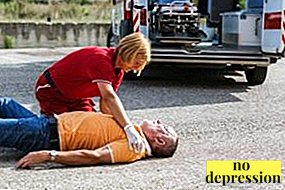When an epilepsy attack occurs, first aid to a person is usually found by nearby people.
Compliance with a set of simple rules will help alleviate the condition of the patient.
Concept

Epileptic seizure - this is an attack triggered by active neural discharges in the brain.
A person at this moment there are disorders of motor, mental, mental activity.
Such a seizure is the main symptom of a chronic neurological disease - epilepsy. People suffering from this disease periodically experience uncontrollable convulsions.
On average, a seizure lasts a few minutes and does not represent a direct danger to a person’s life.
Depending on how the brain is involved in the pathological process, there are two groups of attacks:
- Focal. Focal epilepsy attacks affect specific areas of the brain. Accordingly, the nature of their manifestation is directly dependent on where the neural discharge is located. So, if a pathological process occurs in the area responsible for visual perception, the patient will have corresponding disorders: visual illusions, hallucinations, unnatural images of objects, etc.
- Generalized. They are diagnosed when negative activity covers the cortex of both hemispheres of the brain. Often there is loss of consciousness, severe convulsions and other negative signs.

Perhaps a situation when the seizure initially focal, but as it develops it develops into a generalized epilepsy attack.
In this case, they say about secondary generalization.
In some situations it is difficult to determine the type of attackdue to the similarity of their external manifestations. There are also varieties of seizures that are not amenable to the above classification.
Correct diagnosis is key to assigning effective therapy to a patient suffering from this disease.
The reasons
What can cause an epilepsy attack? Today, the exact reason people encounter this problem is not determined.
It is also not known why in some patients the seizures are single, while others encounter them with a certain frequency.
Signs of illness appear when damaged part of the brain. At the same time, this zone is not completely destroyed, but the affected cells act as sources of pathological discharges.
In practice, the problem is often diagnosed in people suffering from other diseases. In this case, epileptic seizures become a concomitant disease.

The genetic factor also plays a role, as the transmission of the disease has been established by inheritance.
Negative influence of the environment can also trigger the development of the disease.
Most often, experts talk about the following causes of seizures:
- a brain tumor;
- suffered a stroke;
- birth trauma;
- an abscess
- meningitis;
- encephalitis;
- vascular disorders;
- intoxication;
- auto-intoxication;
- traumatic brain injury.
Since the mechanism of the disease is not fully understood, it is almost impossible to prevent its occurrence.
As prophylaxis It is advisable to follow the general recommendations of specialists: to lead a healthy lifestyle, not to drink alcohol and drugs, not to smoke.
Positive effect on the state of the body moderate exercise, proper nutrition and proper rest. It is important to exclude any stresses, increased loads, emotional shocks.
Provoking factors

What can trigger an epilepsy attack?
Scientists identify a number of provoking factors., which can lead to the development of seizure in people suffering from the disease:
- flickering light from a computer or tv;
- lack of sleep;
- stressful states;
- feeling of fear, anger;
- taking potent drugs (eg, psychostimulants);
- the use of alcohol, narcotic substances;
- hyperventilation (rapid, deep breathing);
- some treatments that stimulate the cerebral cortex: physiotherapy, acupuncture, active massage, etc.
- for women - critical days, during which there are significant fluctuations in hormonal levels.
If a person does not have information about which negative factors affect the frequency of seizures, he can again and again unconsciously expose himself to negative effects.
As a result, critical states will be repeated more often. It has been proven that during attacks, the initially affected areas of the cerebral cortex may receive additional damage, causing the disease to progress.

The more often the pathological process is manifested, the more powerful the drugs will be needed by the patient.
When conducting an EEG in a patient, specialists use knowledge of these provoking factors in order to artificially provoke an attack.
This allows increase the information content of the survey, conduct an accurate diagnosis and prescribe the most effective therapy.
So, photostimulation can be used (with different frequency light flashes), sound stimuli, hyperventilation (the patient is asked to breathe often and deeply for several minutes or they suggest that he inflate a balloon).
If, as a result of the examination of a person, factors causing deterioration of the condition are identified, beware of them as much as possible.
This will reduce the frequency of occurrence of attacks, to avoid increasing the doses of drugs that have anti-epileptic effect.
Forerunners
Many people with ailments can recognize in advance the approach of seizures. Someone can do it in hours or minutes, and someone even in a few days.
The combination of sensations that indicate to the patient at the approach of a critical moment is called epileptic aura.

It can be visual, auditory, mental, olfactory, etc.
It all depends on what range of feelings prevails at such a moment.
Accordingly, in different people, forerunners may experience changes in taste sensations, the appearance of a feeling of nervousness, general physical stress, etc.
Symptoms and signs
Large epileptic seizure accompanied by the following characteristic symptoms:
- convulsions, expressed in rhythmic muscle contractions;
- random movements of body parts, including involuntary head turns;
- drooping eyes;
- breath holding;
- salivation;
- increased limb tone (enhanced leg straightening, flexing the arms);
- involuntary urination;
- uncontrolled loss of feces;
- loss of consciousness.
Also, a person may encounter visual hallucinations, a sense of a nonexistent smell (both pleasant and unpleasant), complete disorientation.
Seizure description

A person can scream, make strange grunting sounds.
Similar reactions are observed at the very beginning.
Then there is a loss of control over his body - the patient falls, his body stiffens. Breathing becomes difficult, the skin turn pale.
Next start muscle convulsionsduring which there is a jump in blood pressure. There is an expansion of the pupils, saliva, increased sweating, flushing of the face.
In some cases, possible uncontrolled excretion of urine, feces. During an attack, people can bite your own tongue.
Gradually, the muscles relax, convulsions cease, breathing returns to normal. These signs indicate that the critical stage has been left behind.
What to do?
Usually seizures last no more than two minutes, so it’s enough provide human security during this time and provide the necessary support after.
Often, ignorant people are frightened and lost when faced with a similar situation. Important not to panic and act as quickly as possible, efficiently. This will provide the patient with the necessary first aid.
If the epileptic shock happened to a childshould immediately contact his relatives after the end. Some time after the incident, the child may feel confused, therefore it is desirable to have a number of close people.

If a seizure occurred in a person who has long suffered from a similar problem, call ambulance impractical.
It is enough to be near at a critical moment and to assist after the seizure.
Since this state lasts only a few minutes, the ambulance in any case will come to the end of the attack.
First aid
How to help a person with epilepsy?
The most important rule - you need to act quickly, clearly and at the same time keep yourself calm.
For effective assistance the patient must do the following:
- in the presence of embarrassing clothing to ensure a person to breathe freely
- remove piercing, cutting objects from the reach zone;
- turn your head to the side so that saliva flows down;
- fix the head with a roller;
- give the opportunity to recover.
Condition after the attack

Man it takes some time to recover after what happened.
Often people do not immediately realize that they have just had a seizure.
May be observed confusion, general weakness, stunning, disorientation.
For this reason, it is important not to leave a person alone until he fully recovers.
So, an epileptic seizure always develops according to a similar scenario. Being near sick people it is important not to panic, but to provide first aid quickly and clearly.
How to provide emergency care for an epileptic seizure:



